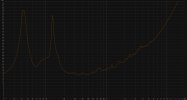This post is aimed at those who use a solid-state power amp into a conventional guitar cab.
As is described in the post "About Speaker LF Resonance" a guitar cabinet has an impedance resonance in the low frequencies. This typically falls in the range of 50 to 100 Hz.
A tube amp, being essentially a current source, will have a voltage output that follows the impedance curve. Speakers, being electromotive devices, respond to applied electromotive force (EMF) which we know as voltage.
A solid-state power amp is a voltage amplifier and, hence, will not be influenced by the impedance of the speaker.
When using a solid-state power amp into a conventional guitar cabinet the experience will be different if the simulated speaker in the Axe-Fx II is not adjusted to match the actual speaker. Whether or not this is important is up to the individual but I imagine a lot of the posts about "in-the-room using power amp and cab is not the same" are due to this. Unfortunately the Axe-Fx II cannot measure the speaker impedance characteristics as it is not directly connected to the speaker. No device can measure the speaker impedance without being directly connected to the speaker, despite what their marketing claims may infer (cough, ahem...), since impedance is, by definition, V/I and we cannot measure these unless connected to the speaker terminals.
The only truly accurate way to set the simulated speaker is to measure the speaker being used with an impedance measuring device. These can be had relatively inexpensively in the form of the Woofer Tester 3 (from Dayton Audio IIRC). You can also make your own using a small value resistor (0.1 ohms or so) in series with you power amp and measure the voltage across the resistor.
The next best method would be to estimate the impedance using published data from the speaker manufacturer. If the make and model are known the data may be available. Add approximately 10% to the published resonance frequency if the speaker is in a sealed box.
The worst method, and the subject of some contention, is finding the resonance by "feel". No power amp has perfect damping. If you put a sine wave (use the Synth block) into the speaker you may be able to observe or feel the resonant frequency. The cone will have increased excursion at this frequency. Of course you may just be feeling the room resonance. I have used this technique successfully on several speakers but it takes practice. The main drawback is that the magnitude of the resonance is unknown.
The Axe-Fx II's Low Res parameter is displayed in dimensionless units from 0 to 10. Each unit corresponds to 2.4 dB of impedance "gain". We define this as a gain since the our current source power amp will experience a voltage gain. This is relative to the DC resistance of the speaker. For example, if the speaker's resistance is 6 ohms and the impedance at resonance is 60 ohms then our impedance gain would be 20*log10(60/6) = 20 dB. Dividing by 2.4 gives a Low Res value of 8.3. Since a tube amp isn't a perfect current source these values should be reduced slightly. The exact value of the Q isn't too important. About 2.0 is a good starting point. Adjust up or down to taste. If you are anal more information is in the aforementioned post about deriving the value of Q.
Once the simulated speaker is set correctly you may notice a difference in low-frequency behavior and pick attack.

